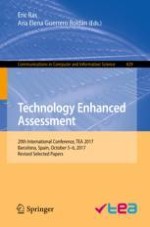2018 | OriginalPaper | Chapter
Calculating the Random Guess Score of Multiple-Response and Matching Test Items
Authors : Silvester Draaijer, Sally Jordan, Helen Ogden
Published in: Technology Enhanced Assessment
Publisher: Springer International Publishing
Activate our intelligent search to find suitable subject content or patents.
Select sections of text to find matching patents with Artificial Intelligence. powered by
Select sections of text to find additional relevant content using AI-assisted search. powered by
